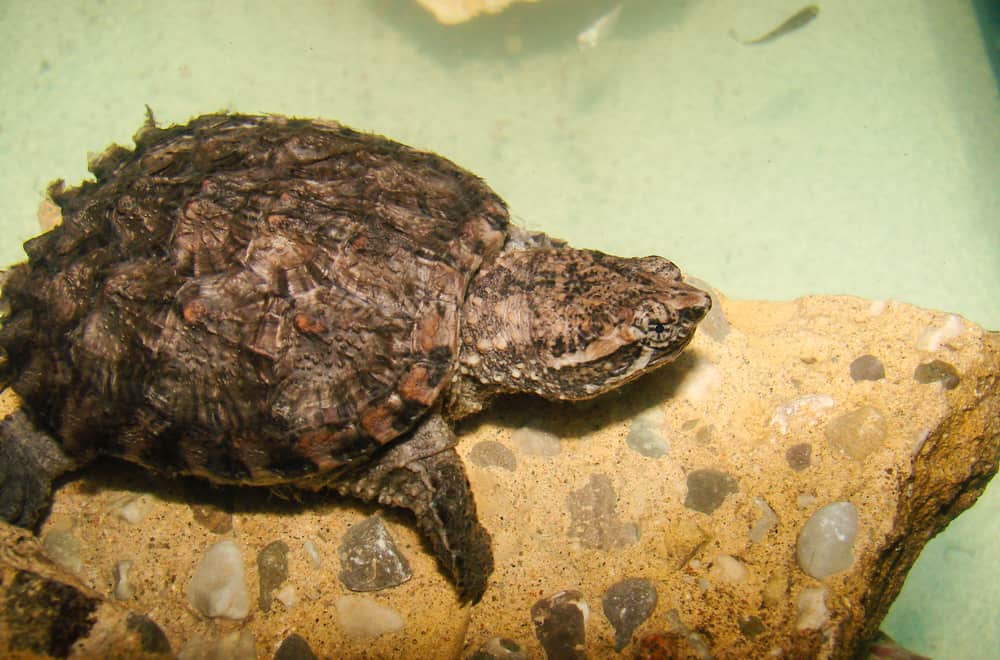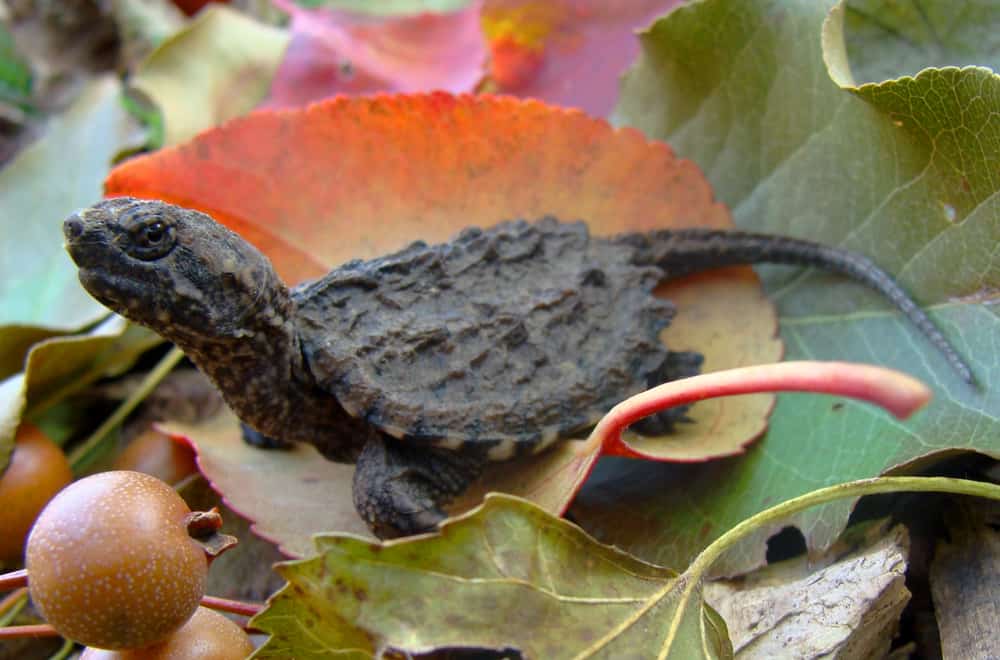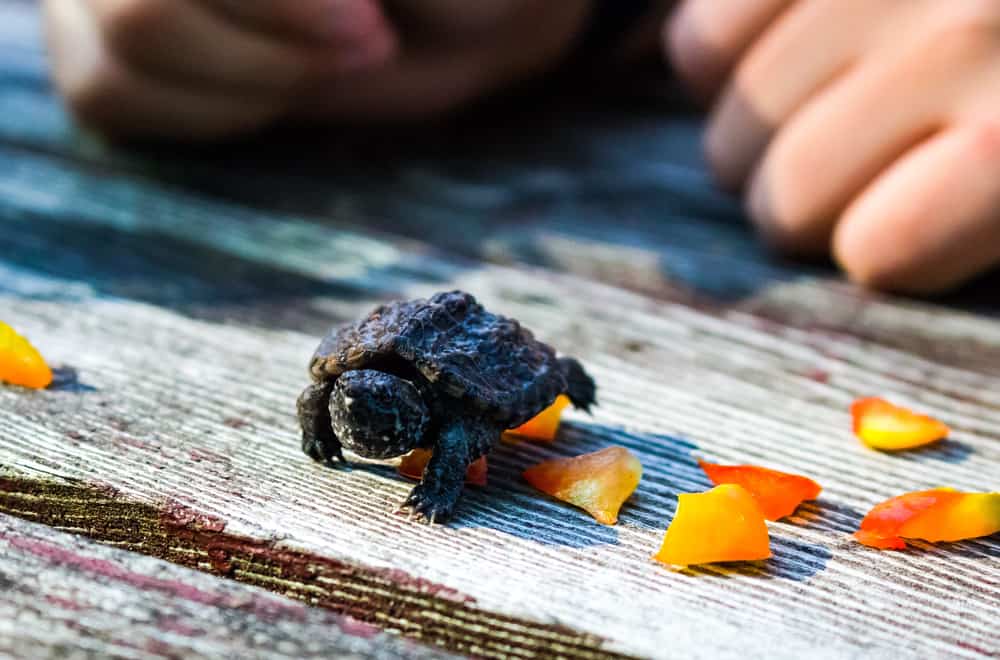If you want exotic pets, you can consider getting a baby Snapping turtle. This little creature is a distant dinosaur cousin, and it looks cute and intimidating at the same time.
However, you may find caring for this cutie quite challenging since its predatory instinct leads this animal to attack anything that moves. Let’s see what do baby Snapping turtles eat.
Baby Snapping Turtles Habits and Biology
The Snapping turtle family (Chelydridae) divides into two types:
- Common Snapping turtles (Chelydra serpentina)
- Alligator Snapping turtles (Machrochelys Temminckii)
Snapping turtles originates in North America and Mexico. Both species are aggressive predators that can turn their large heads almost all the way around to attack. As their name suggests, they snap quickly and have a strong bite.
Generally, baby Snapping turtles grow for approximately 3 inches (7.6 cm) in their first year, so they get big pretty fast. You can expect your pet to grow around 1 inch (2.5 cm) per year after the first year of life.
Average adult male Snapping turtles can be up to 12 inches (30.5 cm) long, while females are bigger and reach 15 inches (38 cm). Alligator Snapping turtles are even larger and can grow over 32 inches (81 cm).
Despite their aggressive behavior, these turtles are popular pets, so you can find them in many exotic pet stores or order them online. A baby turtle under 3 inches (7.5 cm) costs around $15.
Learning about baby Snapping turtles can save you from their bites. For instance, never pull their tail or limbs. Instead, you can grab them by the shell, near their back legs. That way, they won’t reach your hand when you need to pick them up and transfer them to another tank.
Most baby Snapping turtles are active only on land. While observing them, you will notice they are shy in water and often choose to escape and hide under a rock instead of attacking. When they are stressed or frightened, these animals release an unpleasant, musky odor, like skunks.
An average Snapping turtle lifespan is around 30 to 45 years. How long your pet can live primarily depends on your care and whether you provide a suitable habitat for it. Captivity decreases the life expectancy by 5 to 10 years on average.
Snapping turtle females sexually mature around the age of 15. Unfortunately, most hatchlings will die in their first month, so their reproduction rate is extremely low.
Do Baby Snapping Turtles Eat Dirt?
Baby Snapping turtles are omnivores, but they primarily enjoy hunting small animals. The variety in their diet provides plenty of nutrients. Therefore, they won’t eat earth since there is no reason for such behavior.
However, baby Snapping turtles can dig throw the sand and soil while searching for bugs or insects. Sometimes, they can bury themselves during the hibernation period in the wild. On the other hand, baby Snapping turtles will rarely hibernate in captivity since their tank provides a stable temperature over the year.
What Do Baby Snapping Turtles Like to Eat Most
As I have already mentioned, baby Snapping turtles are omnivores. That means you can feed them with almost anything. Still, you need to ensure that their diet contains all the necessary nutrients, including vitamins and minerals. That is why you need a meal plan.
The decisive factor in a baby Snapping turtle’s well-being is balanced nutrition. Meat makes something between 50% and 70% of their diet. The rest are plants, veggies, and fruits that Snapping turtles find in their surroundings. They can even attack their own kind and other turtle types.
Therefore, you need to offer your pet a few different kinds of meat and enough veggies, salads, and fruit. Since these babies are successful hunters, you should also provide some prey for them, including:
- Toads
- Small birds
- Mice
- Otters
- Raccoons
Snapping turtles will happily nibble on mushrooms, dandelion leaves, fallen apples, and carrots. You can also see them enjoying moss or a lily pad they found around. Hatchlings eat more meat than veggies, but mature turtles include more greens in their diet.
Even though adult Snapping turtles need a meal every second or third day, you should feed your baby Snapper daily. Remember that it grows at the maximum speed during the first year.
Protein sources
Nowadays, you can find different brands of commercial turtle food and choose between pellets, granules, and meat chunks. Still, keep in mind that baby Snapping turtles need more protein than other turtle types.
Therefore, it is recommended to provide some living animals to your pet at least occasionally. Not only will it enjoy the hunt, but a piece of fresh meat contains many nutrients. Some of your choices are:
- Waxworms, earthworms, and blood worms
- Shrimp and ghost shrimp
- Fish and feeding fish
- Crickets, flies, and cockroaches
- Snails, small snails, and slugs
- Pink baby mice
- Pollywogs and frogs
- Newts
- Other turtles
- Chicken and turkey meat
- Beef heart and raw liver
Plants
Your tank should imitate a snapper natural environment as close as possible because your baby turtle needs plants in its diet. The best option is to get some aquatic plants your baby Snapping turtle will enjoy, like:
- Algae and moss
- Duckweed and waterweed
- Java Ferns
- Dandelion greens
- Lily pads and Water lilies
Veggies and fruit
Both fruits and veggies contain valuable nutrients for your baby Snapper. Still, too many sugars in fruit can upset your reptile’s stomach, so offering one or two fruity treats a week will be enough.
On the other side, your baby pet can have veggies daily. You should chop them into small pieces and combine them with cooked meat in one meal. Baby Snappers love most fruits and vegetables, but mostly prefer:
- Lettuce and celery
- Carrots and cucumbers
- Apples and pears
- Bananas
- Grapes
- Blackberries and strawberries
- Watermelon
- Tomatoes
Supplements
No matter what your baby Snapping turtle diet includes, it will require some supplements. In general, most Snappers lack calcium, and you should ask your vet for a product recommendation.
Plus, your pet will need additional vitamin D3 if it doesn’t get enough sunlight during the day. Another option is to add a UV lamp to your tank.
Food Avoid to Feed Baby Snapping Turtles
The fact your baby Snapping turtle will eat everything you offer doesn’t mean it benefits from any food. There are categories you should avoid giving to your reptile since they can poison it, upset its digestive tract, or cause a lack of nutrients. Several protein sources you should skip are:
- Goldfish, because they have low nutrient value
- Rosy red minnows since they lead to vitamin B deficiency
- Fishing worms containing toxins
- Wild insects because their living area is usually treated with pesticides
Some fruit has a high level of phosphorus or citric acid. In both cases, your baby Snapper won’t have any benefits from it, so it is better to skip:
- Lemons and limes
- Oranges, grapefruit, and nectarines
- Prunes and raisins
- Dates
- Peaches and apricots
- Avocado and guava
- Banana
- Coconuts
The veggies with high phosphorus values you shouldn’t give your baby turtle include:
- Potatoes and sweet potatoes
- Green beans
- Romaine lettuce
- Corn
- Onion
- Spinach and chard
- Beets and turnips
- Rhubarb and asparagus
- Tomatoes
- Peppers
- Squash and pumpkins
- Cauliflower and brussels sprouts
Besides, you should avoid giving your turtle any sweets, candies, and processed food. This food contains additives and preservatives, leading to serious health problems, like obesity, pyramiding, and kidney problems.
Dairy products are also no-no since baby Snappers can’t process lactose. Some of the plants your turtle shouldn’t eat are:
- Rhododendrons
- Boxwood
- Yew
- Hyacinth
- Azaleas
Tips to Feed Baby Snapping Turtles
Remembering the long lists of do’s and don’ts of a baby Snapping turtle diet is tricky. Still, there are several expert tips advice you should follow:
- Prepare a separate tank for feeding a baby snapper. Otherwise, this creature will make a mess, forcing you to clean its surroundings daily.
- Keep the same water quality and temperature in both tanks to let your pet accept its dinner quicker.
- Wait for your pet to relieve itself after a meal. Usually, it takes around 30 minutes or so before returning the turtle to the original tank.
- All Snapping turtles prefer living prey to any dead offerings. Still, combine fresh food with granules to prevent a stomach ache.
- Don’t forget to replace the water in the turtle’s tank regularly. The best solution is to pour fresh water after every meal.
- The vital thing is to adjust the meal size. Obesity is a common problem for baby Snapping turtles, so you should cut down on meal sizes or restrict feeding time to 15 minutes if your baby looks bulky.
- Contrary, an underweight pet will have loose skin and can become lethargic. If you think it gets enough food but is still skinny, rethink the menu and offer it another type of meat and plants.
Summary
A baby Snapping turtle will bite anything it can get. Offer meat, insects, and plants to your pet, but avoid refined sugar, bakery products, and processed food. Feed your pet in a separate tank to dodge cleaning its habitat daily, and watch your fingers!


